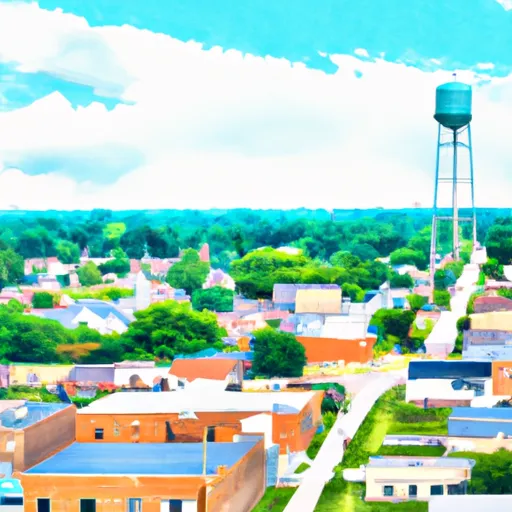-
 Snoflo Premium
Snoflo Premium
Get unlimited access to all our content
With no Ad interruptions! - Start Your Free Trial Login with existing account
Momence
Eden Index
Climate
7.8
•
Recreation
2.8
•
Community
3.5
•
Safeguard
5.0/10

Momence, Illinois is a charming small town located in Kankakee County, known for its beautiful surroundings and various outdoor recreation opportunities. The town experiences a humid continental climate, characterized by hot summers and cold winters. Summers bring average temperatures in the mid-80s°F, while winters see average temperatures ranging from the low 20s°F to the mid-30s°F. Precipitation is evenly distributed throughout the year, with an annual average of around 38 inches.
Hydrologically, Momence is situated along the banks of the Kankakee River, which provides scenic views and opportunities for activities like fishing, boating, and canoeing. The river is home to a diverse range of aquatic species, making it a popular spot for anglers.
In addition to the river, Momence boasts several parks and recreational areas. Island Park, located adjacent to the river, offers picnic areas, playgrounds, and walking trails. Momence Wetlands Nature Preserve provides opportunities for birdwatching and hiking, with its diverse ecosystem of wetlands, forests, and prairies. Overall, Momence offers a unique blend of natural beauty and recreational opportunities for outdoor enthusiasts.
What is the Eden Index?
The Snoflo Eden Index serves as a comprehensive rating system for regions, evaluating their desirability through a holistic assessment of climate health, outdoor recreation opportunities, and natural disaster risk, acknowledging the profound impact of these factors on livability and well-being.
Climate Health Indicator (CHI): 7.8
Momence receives approximately
964mm of rain per year,
with humidity levels near 82%
and air temperatures averaging around
10°C.
Momence has a plant hardyness factor of
5, meaning
plants and agriculture in this region thrive during a short period during spring and early summer. Most
plants will die off during the colder winter months.
By considering the ideal temperature range, reliable water supplies, clean air, and stable seasonal rain or snowpacks, the Climate Health Indicator (CHI) underscores the significance of a healthy climate as the foundation for quality living.
A healthy climate is paramount for ensuring a high quality of life and livability in a region, fostering both physical well-being and environmental harmony. This can be characterized by ideal temperatures, reliable access to water supplies, clean air, and consistent seasonal rain or snowpacks.
Weather Forecast
Streamflow Conditions
Upper Illinois
Area Rivers
Upper Illinois
Snowpack Depths
Upper Illinois
Reservoir Storage Capacity
Upper Illinois
Groundwater Levels
Recreational Opportunity Index (ROI): 2.8
The Recreational Opportunity Index (ROI) recognizes the value of outdoor recreational options, such as parks, hiking trails, camping sites, and fishing spots, while acknowledging that climate plays a pivotal role in ensuring the comfort and consistency of these experiences.
Access to outdoor recreational opportunities, encompassing activities such as parks, hiking, camping, and fishing, is crucial for overall well-being, and the climate plays a pivotal role in enabling and enhancing these experiences, ensuring that individuals can engage in nature-based activities comfortably and consistently.
Camping Areas
| Campground | Campsites | Reservations | Toilets | Showers | Elevation |
|---|---|---|---|---|---|
| Kimmell City Park | 10 | 415 ft | |||
| Paris City Park | None | 668 ft | |||
| Destiny Parks Military - Fort Campbell | None | 544 ft | |||
| Lincoln Trail | None | 412 ft | |||
| Ouabache Trails County Park | 45 | 446 ft | |||
| Mill Creek Park | 140 | 657 ft | |||
| Robinson City Park | None | 541 ft | |||
| Cayuga Park Campground | 29 | 509 ft | |||
| Lincoln Trail State Park | 240 | 655 ft | |||
| Red Hills Lake State Park | 130 | 519 ft |
Nearby Ski Areas
Catastrophe Safeguard Index (CSI):
The Catastrophe Safeguard Index (CSI) recognizes that natural disaster risk, encompassing floods, fires, hurricanes, and tornadoes, can drastically affect safety and the overall appeal of an area.
The level of natural disaster risk in a region significantly affects safety and the overall livability, with climate change amplifying these risks by potentially increasing the frequency and intensity of events like floods, fires, hurricanes, and tornadoes, thereby posing substantial challenges to community resilience and well-being.
Community Resilience Indicator (CRI): 3.5
The Community Resilience Indicator (CRI) recognizes that education, healthcare, and socioeconomics are crucial to the well-being of a region. The CRI acknowledges the profound impact of these elements on residents' overall quality of life. By evaluating educational resources, healthcare accessibility, and economic inclusivity, the index captures the essential aspects that contribute to a thriving community, fostering resident satisfaction, equity, and social cohesion.

